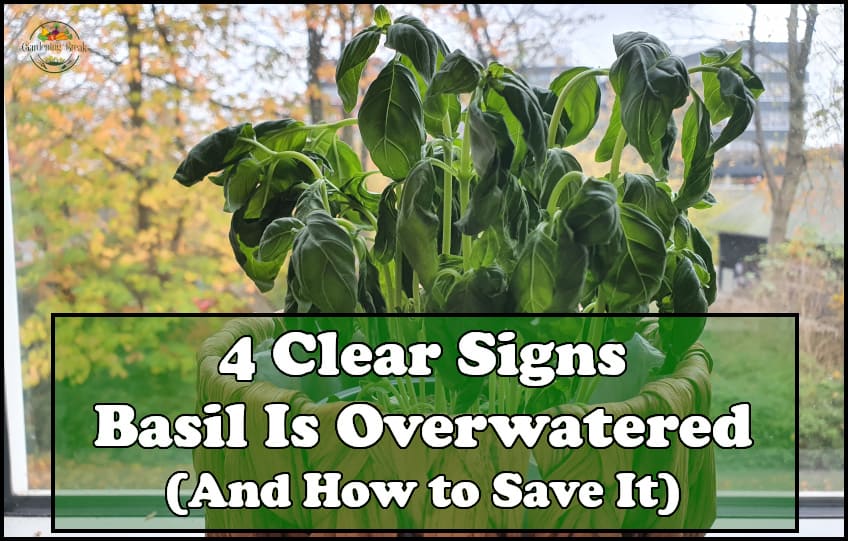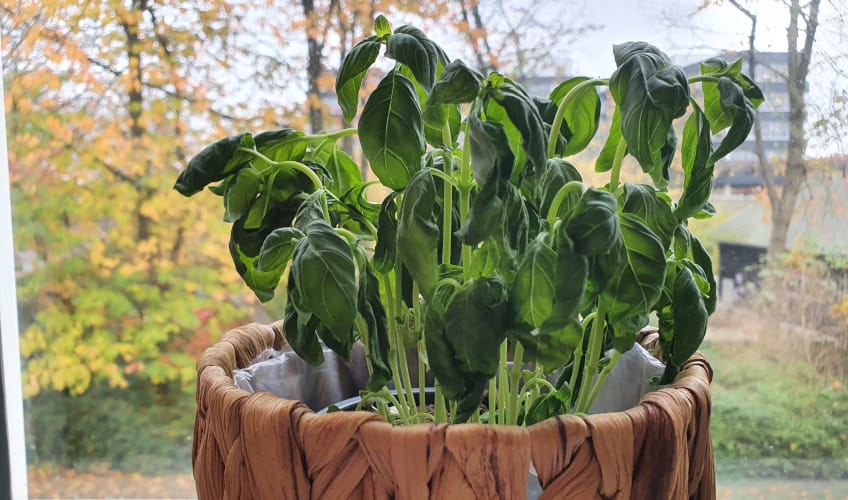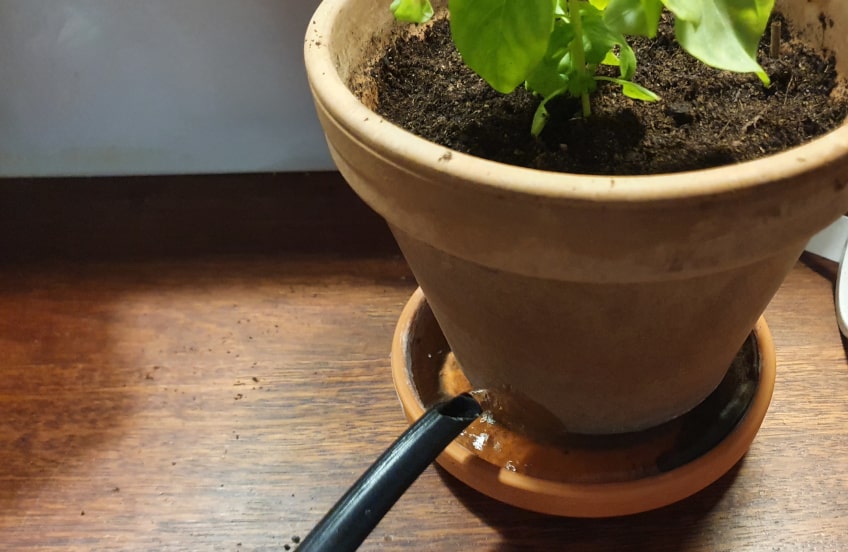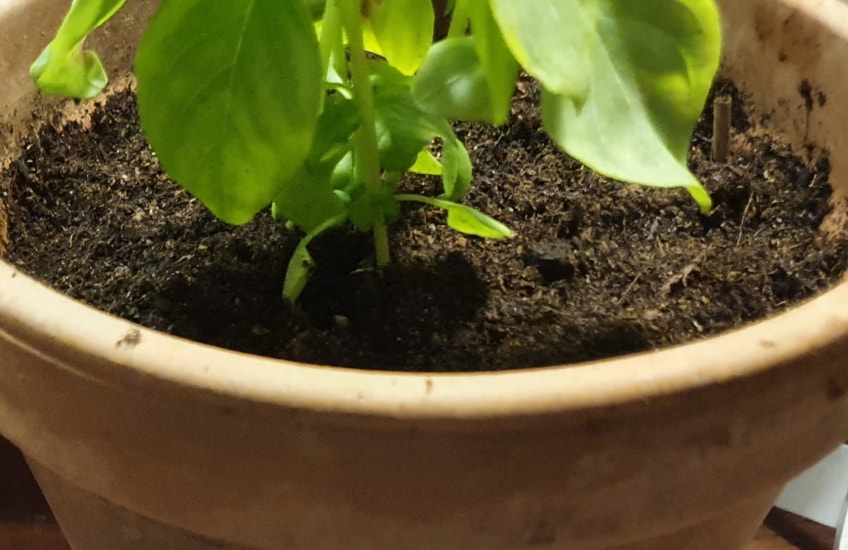Overwatering is probably the most common mistake people make when growing basil. A while ago, I had a basil plant that I suspected had been getting too much water but since I was not sure, I reached out to a professional gardener I know who has decades of experience. I asked him exactly how to know and this is what he told me.
The first signs basil plants show of being overwatered are wilting and yellowing leaves. Wilting can also happen because of underwatering, however, so you can check the soil to be sure. If the soil is wet and soggy and your basil is wilting and getting yellow leaves, overwatering is most likely the problem.
Wilting, yellowing leaves, and soggy soil are the primary signs to look for, but they are not the only signs you should know about.
As the problem becomes more severe, your basil will show more signs that it is overwatered. In this article, I explain precisely what you should look for so you can stop the problem before it is too late. I also explain how to save your plant and how to avoid the problem in the future, so keep reading.

How to Tell if Basil Plants Are Overwatered
Overwatering is one of the most common mistakes people make when they grow basil. One of the reasons is that some of the symptoms are very similar to the symptoms basil shows when it is underwatered, which can make people water it even more.
So how exactly can you know for sure that overwatering is the problem?
In my experience, the easiest way to tell is to feel the soil. If the soil dries out completely between watering, you are underwatering your basil. If the soil is wet or soggy and has been for some time, overwatering is almost certainly the issue.
I have made a list of four clear signs you should look for to be certain.
4 Signs Basil Plants Show When They Are Overwatered
Basil was one of the first plants I started growing and I have been growing it for many years now. I have overwatered my plants several times over the years, but it almost never happens anymore since I know what signs to look out for now.
Basil is quite sensitive to too much water and moisture so they are easy to overwater but if you look out for these signs, you are already doing good. The most important thing you can do to avoid the issue is to know how to water it properly. I have a guide for that here.
Here are the four signs basil plants show when they are overwatered.
1. The plant is wilting
After a basil plant has been getting too much water for some time, the leaves will begin to wilt which essentially means that they start to get soft and hang loose rather than looking fresh and strong.
Wilting can often look like the plant is thirsty so it is a common mistake to give the plant even more water even though too much water is the problem in the first place.
Here is a photo of a wilting basil plant so you know exactly what to look for.

The reason why wilting reduces plants’ ability to get rid of water is that when they get soft and fold, they will not have as much surface area and will therefore not be able to absorb as much sunlight.
Keep in mind that wilting can happen for other reasons than overwatering, so see if your basil is also showing some of the other signs from this list.
2. Leaves begin to turn yellow
Other than wilting, one of the first signs to look out for when you suspect that you have been overwatering your basil is the leaves. They will begin to turn yellow or brown, starting from the bottom and then slowly moving up toward the top of the plant.
It doesn’t take that long for some of the lower leaves to start turning yellow when a basil plant has been getting too much water, so it is an important sign to look for.
Yellowing leaves can also happen for other reasons though. If the leaves on your basil plant are turning yellow but the plant is not showing any of the other signs from this list, I recommend that you head over to the article on this link, where I cover 12 of the most common problems people have when they grow basil.
3. The soil stays wet and soggy for a long time after watering
Another common sign that you have been overwatering your basil is that the top of the soil does not dry out.
Overwatering essentially means that a plant has been getting more water than it can use. When that happens, the excess water will stay in the soil around the roots for a long time.
When that happens, it will take a while for the soil to dry out, so it is important to check the soil before you water your basil.
When it has been going on for too long, mold will start to appear, which is my next point.
4. A smell of mold comes from the soil
If you notice a moldy smell coming from the soil your basil is growing in, it has most likely been overwatered for a long time and the roots are probably starting to rot, which kills the plant if you don’t take care of it. It is not necessarily super critical yet, though, but you have to take action.
How to Save Overwatered Basil (Depending on How Bad It Is)
Overwatering will kill your basil plant if you don’t solve the problem in time. Luckily, there are several things you can do to save your plant. Below, I explain what I have done in the past to save my basil plants when they have been overwatered.

There are several things you can do to save overwatered basil plants. Of course, the most important thing is to know how to water it properly but if the damage is already done, you need to save it. I have some good tricks for that. It depends on how severe the damage is, though.
If you just need to know the basics, stay here, but if you want a more detailed guide on how to save overwatered basil, I have written another article with a step-by-step guide with photos that show precisely how to do it. I encourage you to check out that post on this link.
The best way to save overwatered basil where the damage is not so severe is to remove any yellow or brown growth and then just water the plant less. Only water basil when the top of the soil is dry. Don’t allow all of the soil to dry out, however, as basil needs to grow in moist soil.
If the damage is more serious, we need to turn to more drastic measures.
A severely overwatered basil should be transplanted into a larger pot or the ground. The extra soil can help absorb some of the excess water and relieve the roots of some of the stress. I have a guide for that here.
If you aren’t sure which type of pot is best for your basil plant, I explain what you should know here.
How Often to Water Basil to Avoid Overwatering
How often you should water basil depends on many things such as where your plant is growing, how much direct sunlight it receives, how high the temperature is, and how large your plant is.
So it is impossible to tell you exactly how often you should water your basil but here are some guidelines that you can use to know exactly how often you should do it to avoid overwatering.
- Don’t water your basil on a schedule but wait for the signs.
- Don’t water your basil before the top of the soil looks and feels dry.
- Don’t allow more than just the top of the soil to dry out before you water.
- Water your basil in the morning.
Feeling the top of the soil is the best trick I know when it comes to determining if you need to water basil or not. It is important that you don’t allow the rest of the soil to dry out, though, since the roots can die if the soil is too dry.
It can be hard to show in a photo, but I have tried. The soil should look somewhat similar to this. Not completely dry but definitely also not soggy or wet.

There are a couple of reasons why you should water your basil in the morning.
First of all, if you water when the sun is at its highest point and the temperatures are high, the water can evaporate quickly and prevent the basil from actually obtaining it.
In addition to that, the water that stays on the ground can be heated up quickly and in some extreme cases essentially “cook” the plant.
Watering in the morning before there is too much direct sun and the temperature is too high allows the water to sink into the soil more easily and thereby lets the plant obtain it much more efficiently.
How often you should water your basil depends a lot on the weather. The warmer and sunnier it is, the more water your basil needs. The key thing to look out for is the top of the soil. When it is dry, it is time to water. And if possible, water from the bottom since that promotes root growth.
It is generally also a great idea to water your basil from the bottom as shown in the photo above since it forces the roots to grow and seek out the water and a larger, stronger root system leads to healthier, faster-growing plants. You can read more about why bottom watering is such an effective way to help save overwatered plants and avoid the problem in the future on this on this link.
Read My Complete Guide to Growing and Caring for Basil
I have written a thorough guide where I cover all parts of growing your own basil including choosing a variety, sowing the seeds, the best growing conditions, pruning, propagation, harvesting, storing, solving various problems, and a lot more. You can find the article on this link.

